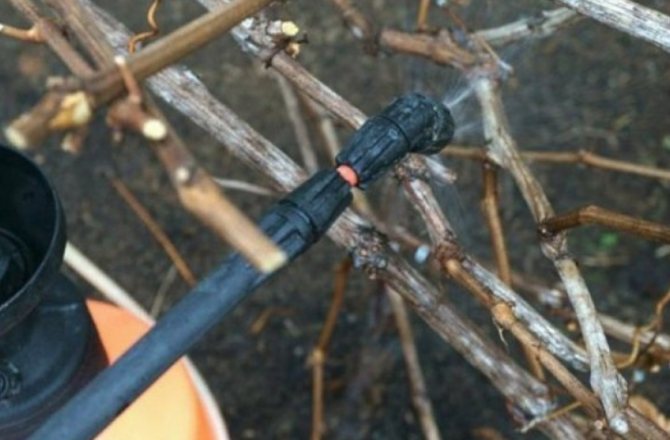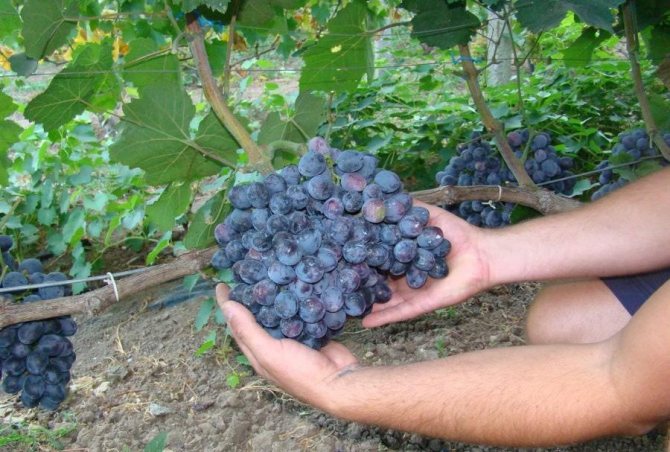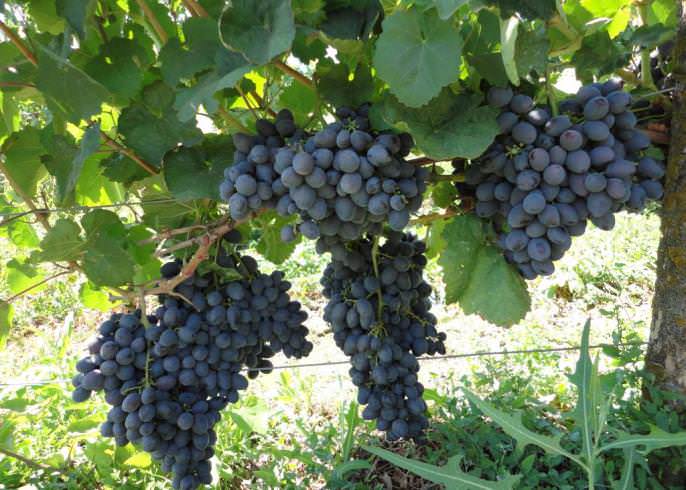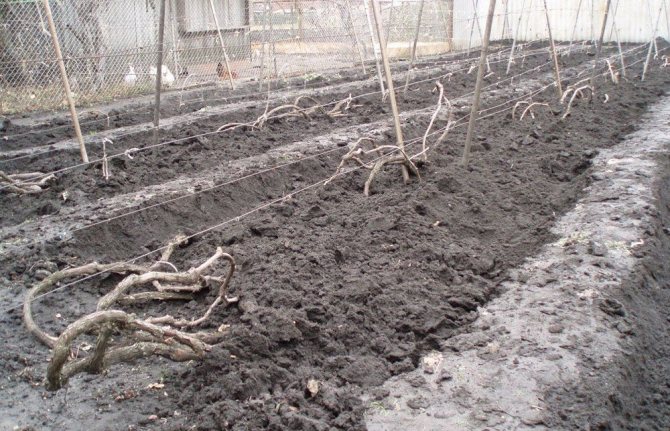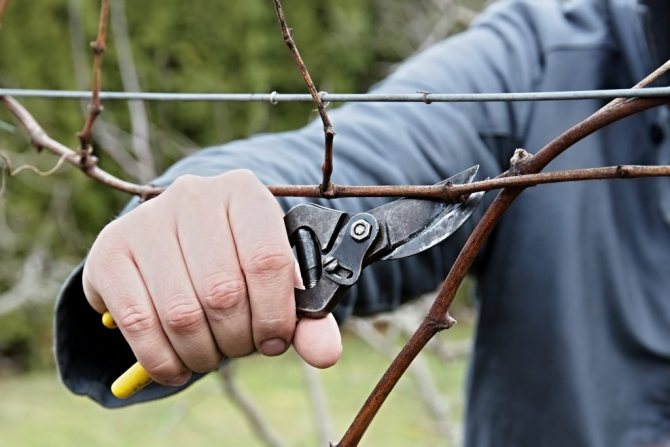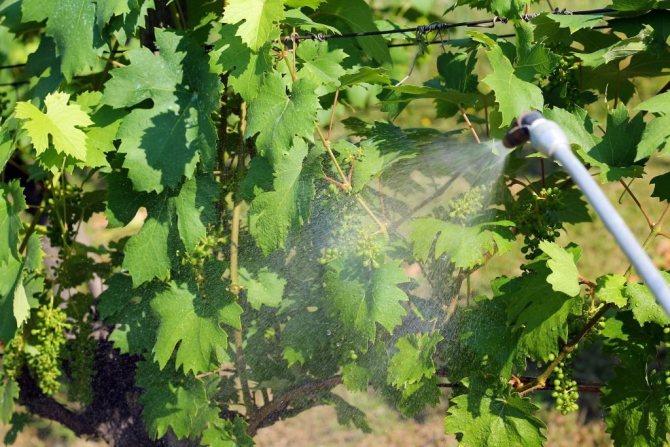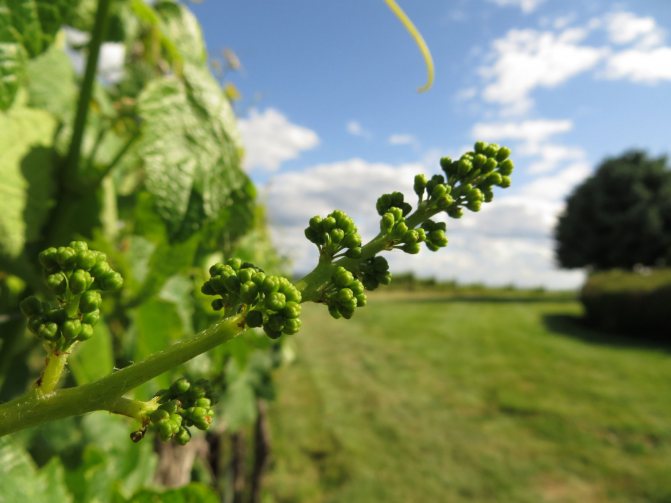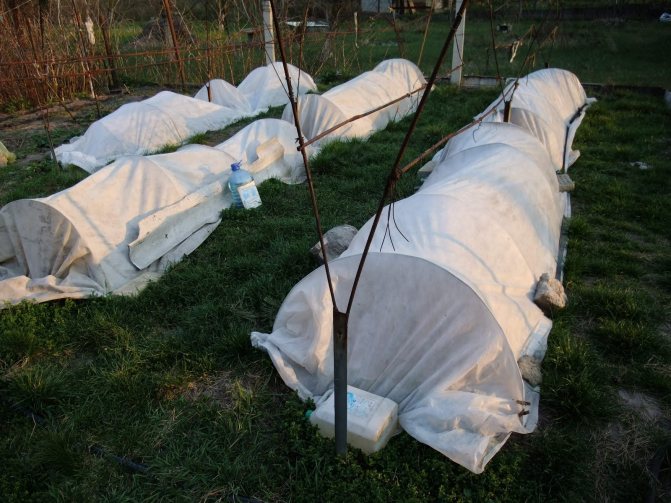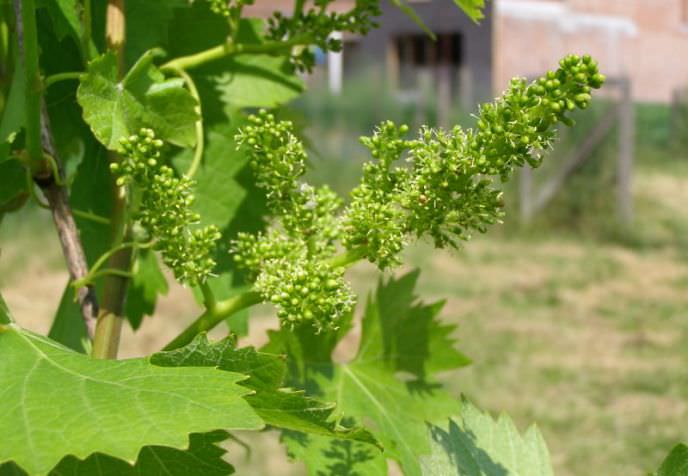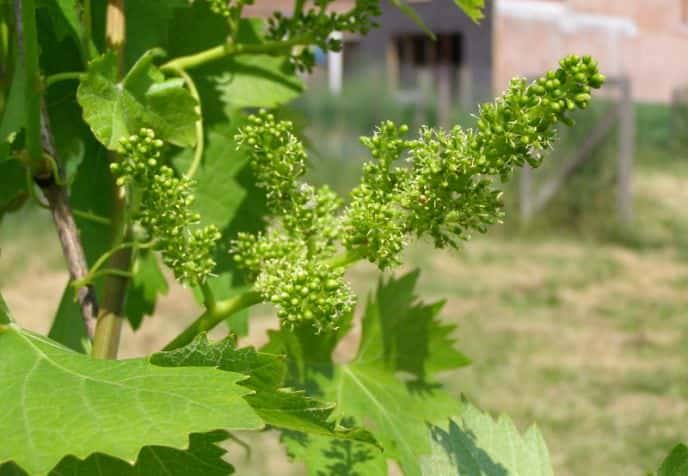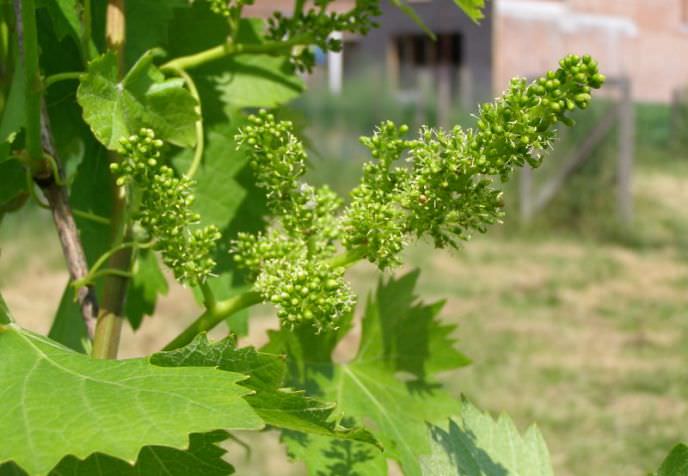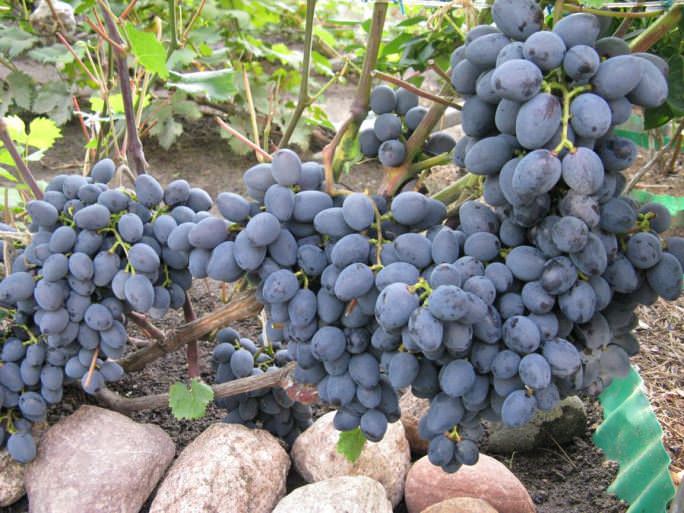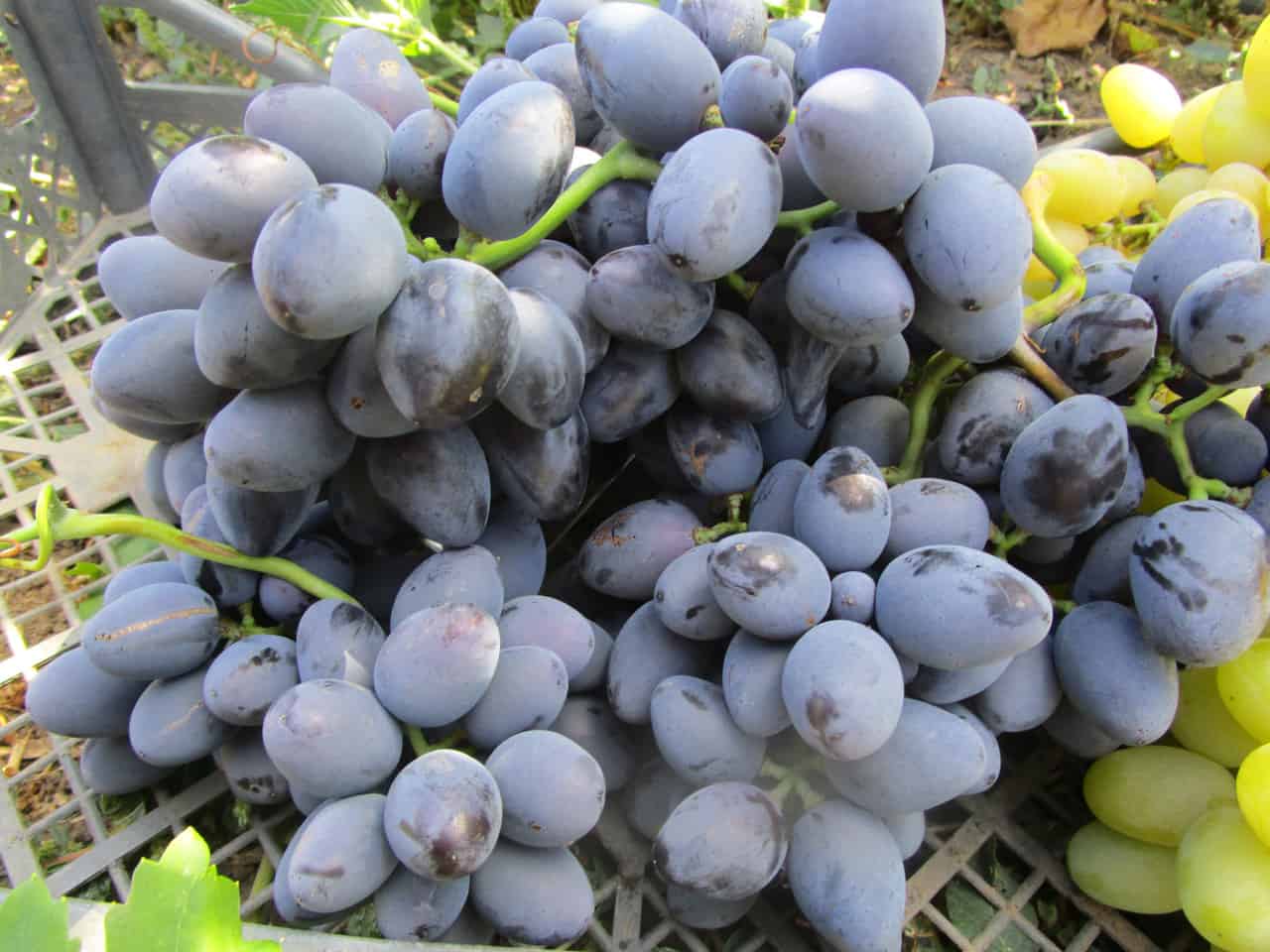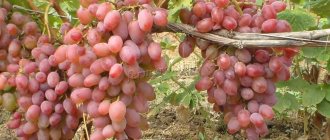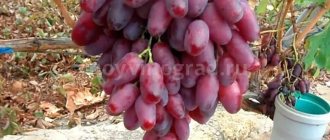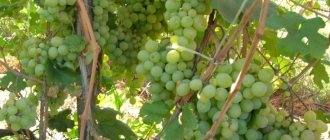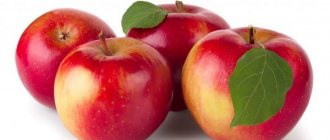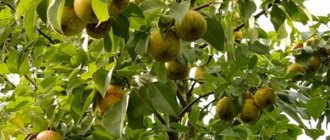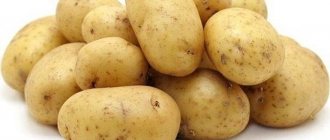Gala characteristics table
| General information about the variety | |
| Parent couple | "Kodryanka" and "Gift of Zaporozhye" |
| The author of the variety: | V.V. Zagorulko |
| Main characteristics | |
| Purpose: | dining room |
| Ripening time: | early |
| Productivity: | high |
| Taste: | harmonious |
| Color: | dark blue |
| Frost resistance: | up to - 21 ° C |
| Description of a bunch of grapes | |
| Bunch weight: | 1000-2000 gr. |
| Density of the bunch: | medium-dense |
| Description of grapes | |
| Berry shape: | elongated oval |
| Berry weight | 9-12 gr. |
| Diseases | |
| Disease resistance: | Resistance to mildew, powdery mildew - 3-3.5 points |
Grapes are a sweet and sour juicy berry popular today far beyond the southern regions. This distribution of grapes was due to its high taste and the discovery of hybrid forms, allowing it to be grown in temperate latitudes. We will talk about one of these varieties today.
Characteristics of the variety
Gala grapes are a fast ripening variety. The period of full maturity (from the beginning of active spring growth) is 4 - 4.5 months. Brings a stable and rich harvest. Frost resistance and sensitivity to diseases are average. Shoots grow well and bear fruit at temperatures down to -18 C.
From the description of the variety, it can be seen that, at the same time, this culture is quite demanding on the growing conditions provided to it and high-quality care.
The Gala grape from the amateur selection of V.V. Zagorulko was obtained by crossing the Gift to Zaporozhye variety and the popular Codryanka grape. The hybrid form is characterized by an early ripening period of 110–125 days.
Bushes of this hybrid form have strong growth and form well-ripening shoots with large leaves. The flowering is bisexual, which ensures high-quality and stable pollination. Large clusters can reach a weight of 1.5-2 kg and have a conical or cylindro-conical shape, have an average density.
Fully ripened large berries are characterized by evenness, oval shape, dark blue coloration. The average weight of a berry varies from 8 to 12 g. The taste qualities of the grapes are quite high. The taste of the fleshy pulp is harmonious, but not sophisticated. The standard values for the accumulation of sugars slightly exceed 16% with the acidity of the juice up to 6.8 g / l. The berries are not prone to peas.

The variety has a high rate of transportability. Berries do not crack, do not crumble, do not lose their presentation during transportation. Arkadia, Angelica and Amethyst Novocherkassky show themselves well during transportation.
It is worth noting that the grapes do not lose their appearance and taste as well, being on the bush for some time after ripening. It is not worth delaying the harvesting process.
If you want to preserve the crop after harvesting, you should only remove the bunches in dry, sunny and warm weather. On cloudy, rainy days, grapes do not lie for a long time after removal. There may be problems with the transportation of berries.
The bushes bear fruit well. With regular and proper care, grapes will yield bountiful harvests every year.
According to the conducted selection studies, the ripening of shoots is up to 80-85%, the percentage of fruitful shoots is 65-75%, and the average fruiting factor is estimated at 1.3-1.5.
Bountiful harvests are also guaranteed by such varieties as Gift of Magarach, Jubilee of the Kherson summer resident and Rkatsiteli.
Galahad is resistant to severe frosts and can withstand temperature drops up to -25 degrees. Do not forget to take care of a reliable shelter for the winter when growing in our climatic zone.
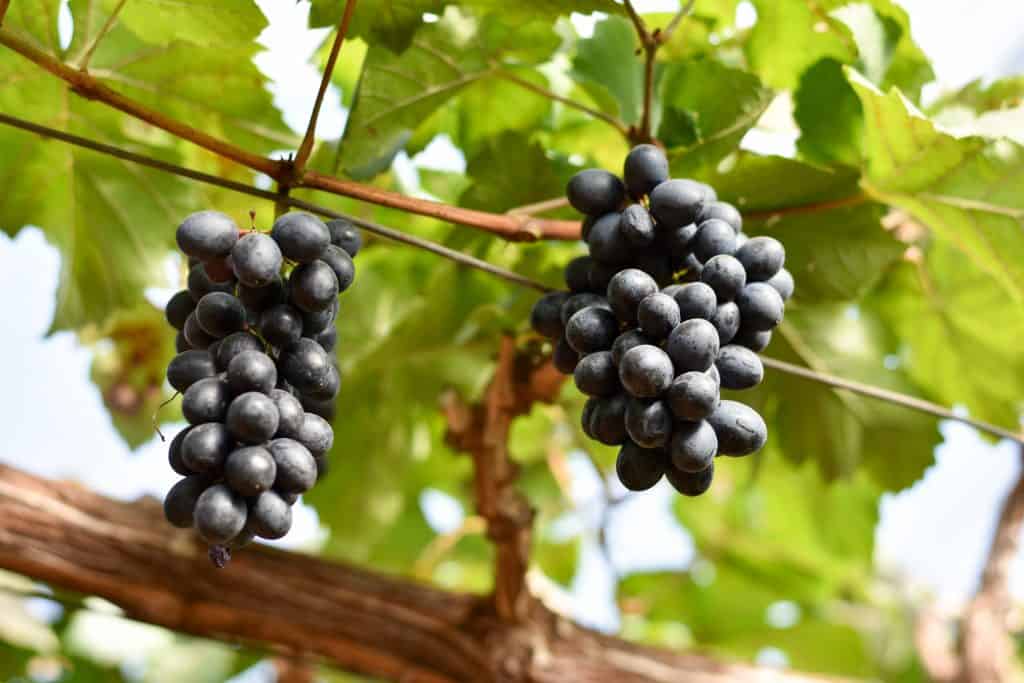

Grapes are a very thermophilic plant that has a hard time surviving cold winters without shelter. You should not stop the choice on partial shelter, since it will not be able to provide adequate protection.
Pay attention to the formation of bushes of young plants. Cuttings root quickly, give a high growth. Grapes often begin to bear fruit abundantly in the first years of life.
As a result, without proper care, this can lead to overloading of bushes, breaking off branches, diseases, and a decrease in the quality of yields. Therefore, in the early years it is especially important to thin out the grapes. It is recommended to prune the vine for fruiting by 6-8 eyes.
Main factors
Crossing of Kodryanka and Gift to Zaporozhye, gave reliability and stability to the new hybrid variety. It has a wonderful trade appearance, stands out in the product line, and attracts attention with its balanced taste.
Typical properties include description:
- Ripening occurs in early or mid-early terms (110 - 125 days).
- The growth force of the bushes is great. Tall, they are covered with wide leaves. The vine is of excellent maturation.
- Self-pollinated variety with bisexual flowers.
- Berries of considerable volume and weight, oval, blue. The mass of one fruit reaches 12 g;
- Brushes weigh 0.5 - 1 kg (there are specimens up to 2 kg), cylindrical or conical in appearance.
- There are no peas.
- The taste is balanced, soft.
- Fleshy inside of the berry, juicy.
- Acidity is about 7 g / l.
- Sugar content 16%.
The fruiting factor is not too high (1.3). Ripening is delayed when the vine is overloaded, deteriorating the quality and taste of the berries. The yield is always high.
Seedlings take root successfully. Rarely becomes infected with mildew, powdery mildew. Moderate frost resistance (-21 ° C).
It does not remain on the bushes for a long time, as it is immediately damaged by wasps. Excess moisture leads to cracks in the fruit, which is not prone to decay.
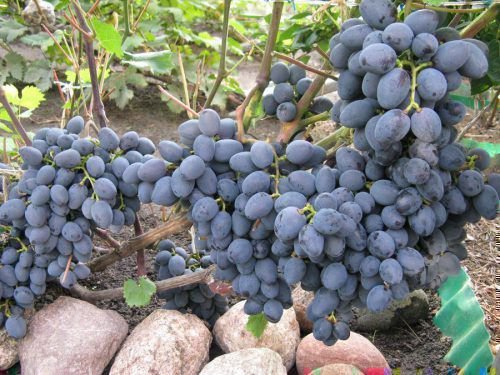

Gala grapes should be removed from the bushes immediately after ripening.
Breeding history and breeding region
Galahad belongs to the new modern varieties. It was obtained as a result of a complex crossing of several grape varieties. For this, breeders crossed Delight with Talisman (Kesha), and then with Muscat Delight.
Galahad has successfully passed the tests and is suitable for growing in different regions of Russia, as well as in the neighboring countries.
Galia is a hybrid form of table grapes, bred by an amateur breeder Vasily Ulyanovich Kapelyushny and tested by him in the Nadezhda farm in the Aksai district of the Rostov region.
Galia hybrid grape is an early ripening variety with tasty, sweet berries
Gala grapes are the result of the work of a famous Ukrainian breeder. Vitaliy Zagorulko combined two different varieties - "kodryanka" and "gift from Zaporozhye". Thanks to the successful combination, we have obtained a variety that grows well in our climate. Initially, grapes were quite expensive, for one seedling they asked for about two thousand rubles.
The most important thing
Gala grapes, the description of which we present to you, belongs to the table species. The berries are deep blue in color and have a pronounced taste. Gala ripens relatively early, which makes the variety even more attractive for cultivation. After all, everyone wants to have bushes in their garden, the crops from which can be removed earlier than others do. Most often, this particular variety you see on the shelves, while others are just beginning to ripen.
general information
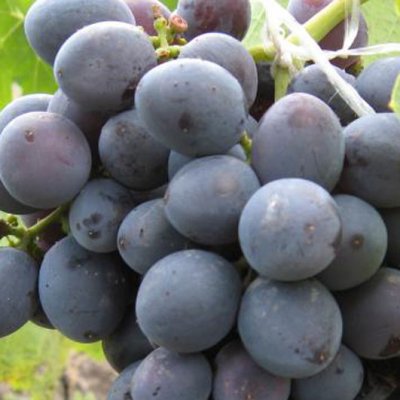

Type of variety: table.
Berry color: blue... Just like Augusta, Witch's Fingers and Carmacoda.
Gala is an early ripening variety that produces large juicy berries with a bright taste and attractive appearance.
Due to its fast ripening, Gala grapes are ready for consumption earlier than many other varieties, which makes it highly competitive in the market and popular among gardeners with different levels of experience.
Moor, Angelica and Valek are also distinguished by early maturity.
Testimonials
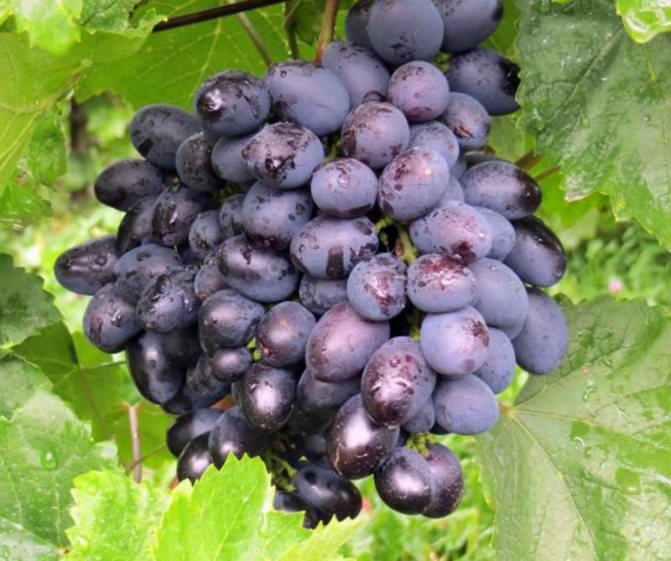

Today Gala grapes are chosen by winegrowers as a crop suitable for growing in greenhouse conditions. If the soil is adapted for growing this variety, then this allows you to collect bunches of up to 2 kg. But, like all hybrids, a problem with pollination can be distinguished, this can be seen from the uneven ripening of berries.
To date, the hybrid form "Gala" has already been tested by winegrowers as a crop for growing in a greenhouse. In protected ground, the variety has shown itself very well and allows you to get bunches weighing up to 2 kg. However, certain problems were noticed with the implementation of pollination, which is expressed in some unevenness of the berries.
"Gala" ripens perfectly and does not cause much trouble to the gardener when cultivating on a personal plot.
The hybrid form of Gala grapes compares favorably with other new early-ripening dark-colored varieties with a high level of fruiting stability and reliability. These grapes really deserve the attention of amateur gardeners due to their excellent marketability and the ability to get an early harvest.
Galia, like many other forms of V.U. Kapelyushny, found both her admirers and strict critics. Among those who criticize this grape are mainly professional winegrowers, who are important not only for the characteristics of the variety, but also for its uniqueness, obvious differences from other varieties. Of the minuses, they often note, firstly, unstable pollination and, secondly, a tendency to peel berries (which is often the result of poor pollination or overloading the bush).
In positive reviews of the variety, gardeners note the early ripening period and the pleasant taste of the berries.
Galia is not as widely known as similar varieties such as Ricillier. But its advantages - a very early ripening period, unpretentious care and high-quality tasty berries - make the variety a desirable acquisition for many wine growers and amateur gardeners.
Competently executed agricultural technology, which consists in watering, feeding, pruning the crop and protecting it from pests, ensures a stable and rich grape harvest.
Watering and fertilizing
Excessive watering is detrimental to Gala, so the plants should be properly moisturized. The first moistening is carried out after planting the plant, all subsequent ones - as the soil dries out. Most of all moisture is needed for grapes during the growing season. At this time, it is abundantly moistened, pouring into the holes dug around the bush, from 60 to 80 liters, depending on weather conditions, warm, settled water.
Irrigation should be stopped when the crop has entered the flowering phase. Due to the large amount of moisture, the flowers will begin to crumble, which will lead to a decrease in the amount of harvest. Also, you can not water the grapes during the ripening period, as their skin will crack. To ensure the most competent moisture, you should organize a drainage irrigation system or make several depressions around the trunk, 35-40 cm deep.
We must not forget about the regular application of fertilizers, to which Gala reacts very positively. It is recommended to add organic and mineral products in turn. The first feeding is carried out immediately after winter, the second and subsequent ones - before and after the flowering period.
Important: Young plants can thrive without fertilization.But crops older than 3 years need at least three additional fertilizing per season.
When caring for Gala, it is necessary to prune and form a bush. If we neglect this event, then the load on the plant will increase, which will negatively affect the size of the fruits and their taste.
Pruning should be done in early spring or fall. During autumn pruning, long shoots are shortened, leaving a maximum of 8 buds. In this case, the total number of eyes on the bush should not exceed 45. Spring formation is aimed at removing dry, stiff or weak shoots. In addition, with its help, the rationing of the yield is carried out - two clusters are left on part of the shoots, on the other part - one at a time.
Mulching
The mulching procedure, which is carried out throughout the entire growing season of the grapes, starting from the moment of planting the seedling and ending with the immersion of the culture in a state of winter sleep, allows the mulching procedure to retain a sufficient amount of moisture in the soil, protect the grapes from weeds, enrich the soil with oxygen and valuable components.
Did you know? If you sow parsley under a grape bush, it will be healthier and stronger. The thing is that the greenery protects the plant from pests and inhibits the growth of weeds.
Sheltering
Method 1:
- All the branches of the bush are carefully collected, tied with an elastic, but not rigid rope, laid on a special bedding material and fixed.
- Install metal arcs in the ground near the bush and stretch a plastic wrap over them.
- Sprinkle the structure with soil on all sides to protect it from sudden gusts of wind or heavy snowfall.
Method 2:
- Collect the branches of the plant, tie, lay on the previously prepared bedding.
- Sprinkle with a fairly large layer of soil.
The latter method can be practiced in regions with moderate climatic conditions, where temperature indicators in winter do not fall below -15 ° C.
The variety is quite resistant to frost, able to withstand up to -21 degrees. So this grape has an average frost resistance.
Roman, Kryvyi Rih
Grigory, Tver
Vigorous grape bushes with a fairly massive trunk and strong branches. Leaves of medium and large size, light green with pronounced golden-yellow veins, serrated at the ends. Their shape resembles black currant leaves. The flower is bisexual.
Bisexual flowers are also possessed by Princess Olga and the Anniversary of the Kherson summer resident.
A bunch of regular cylindrical-conical shape, medium density or slightly loose, large. Weight from 600 to 1100 grams.
Berries of medium size (27x21 mm). With proper care and regular feeding, larger ones (33x25 mm) are formed.
The average weight of each is 10 grams, up to a maximum of 13-15 grams. The berries are light green, and when ripe, they acquire a beautiful amber-yellow hue and are covered with a matte waxy bloom.
The pulp is fleshy, juicy, tasty, the skin is thin and almost not felt while eating. Grapes contain up to 21 g / 100 cm3 of sugar content with an acidity of 5-6 g / dm3.
It is worth noting that Galahad received a high tasting taste rating, which was about 9 points.
The variety is best suited for fresh consumption, as well as for making homemade preserves, jams, pastries and other sweet dishes.
Such varieties as Korolek, Aleshenkin dar and Ataman are recommended for fresh consumption.
There are several important points to be aware of before starting such a bush. Firstly, you need to familiarize yourself with the characteristics of the variety, and secondly, with the rules for caring for it. This will help you in your choice and will not allow you to make mistakes later during cultivation. So, what are the "gala" grapes:
- berries have an elongated oval shape and tender pulp, the sweet taste of grapes has a slight sourness;
- the brushes have an impressive cone-shaped appearance, and each berry can reach nine grams; as a result, you can get very large brushes;
- large leaves help create a good shade, so many plant this variety not only for the sake of the harvest, but also for the design of a gazebo or arch;
- the plant is pollinated on its own, so there are no problems with the ripening of berries, as well as with the underdevelopment of the tassels, like in many other varieties;
- excellent frost tolerance makes it possible to grow this grape in regions with a cold climate, it winters calmly at a temperature of -21;
- the advantage of the variety is the ability to resist attacks of diseases and pests; often the owner does not need to additionally treat the plant with chemicals;
- the disadvantage is the fact that if you do not harvest on time, the berries begin to crack, juice flows out, which attracts wasps.
Summing up, I would like to note that the gardeners' reviews clearly show all the advantages of this variety. The plant does not require special care, but the harvest exceeds all expectations. This type is especially praised by those who make money by selling early grape varieties. People are happy to buy berries that they missed during the winter.
Meaning for a person
The Gala variety is used fresh, as an independent, very useful product. Delicious, fleshy berries are a great dessert dish. In private farmsteads, citizens make homemade wine from dark berries, which has a sweet, sweet and sour, specific pleasant aroma. Raisins are made from grapes, including them in various culinary recipes.
According to the effect on the body, the description of the properties is lined up in a long list. It is effective for the treatment and prevention of many diseases:
- Promotes elasticity, cleansing of the lungs, bronchi.
- Makes blood vessels more plastic by lowering pressure.
- Relieves insomnia, facilitates overcoming stress.
- Fills the joints, muscles with strength.
- Helps with female diseases.
- It inhibits the growth of neoplasms.
- Improves brain function.
- Removes toxins from the body.
- Makes skin, hair, nails strong, strong and healthy.
Read also: Grapes "Raspberry Super": characteristics, advantages and disadvantages
It should be used with caution in large quantities for gout, caries, ulcers, restrictions of the attending doctor. It is not advised to get carried away by expectant mothers in the last trimester of pregnancy.


Gala grapes are not only tasty, but also extremely healthy.
The chemical composition of dark berries of the variety contains a list of macro- and microelements, vitamins (PP, C, A, K, B, E). It includes compounds: iron-manganese, zinc-selenium, sodium-calcium, choline-phosphorus. Amino acids contained in fruits stimulate metabolic processes, synthesize hormones and proteins. Due to their low calorie content, grapes are used in the dietary menu.
The advantages of Gala are highlighted in the descriptions by everyone who grows this variety. These include:
- smart appearance;
- large bunches and berries;
- consistently pleasing harvest;
- low susceptibility to fungi;
- excellent aging;
- well tolerated transportation.
Among the disadvantages are: low frost resistance, cracking of fruits with excess moisture.
A worthy representative of table varieties, Gala can take its place on the vineyards' homestead lands. I would like to note the wonderful berry with a lyrical statement by the great poet A.S. Pushkin:
“I will not regret the roses, Faded with a light spring; I love the grapes on the vines, In the hands ripened under the mountain, The beauty of my glorious valley, The joy of golden autumn, Oblong and transparent, Like the fingers of a young maiden. "
Description of variety care
The main methods of growing grapes of the hybrid form of Galia are the same as for many other varieties and forms.Galia is quite unpretentious in care, but some of the features of the variety listed below still need to be taken into account in order to get a high-quality harvest.
The cuttings of the variety are easily rooted, therefore, with the planting of Galia, wine growers and gardeners usually do not have problems. Galia is also well compatible with rootstocks. Strong rootstocks, such as Ferkal, are recommended for her.
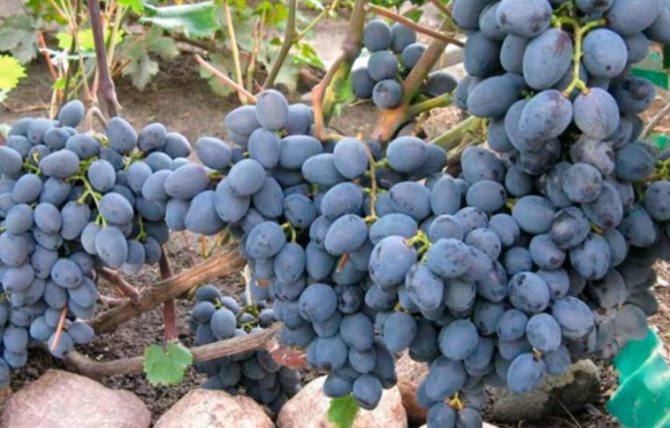

In order for the berries to acquire a rich dark blue color, during their ripening period, it is necessary to open the bunches access to sunlight - to remove the leaves around them.
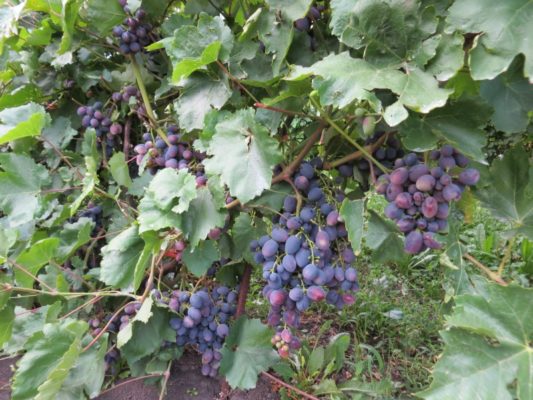

In order for the berries to acquire a rich dark blue color, during their ripening period, you need to remove the leaves that block the access to light for the bunches.
Galia has a high resistance to mildew, powdery mildew and gray rot (2–2.5 points), therefore, for the prevention of these diseases, standard methods are sufficient: remove weeds and excess shoots in time, carry out fungicide treatments.
During the growing season, grapes need moisture. You can water the first time when all the frosts have already passed. If the pruning goes well, you can water it again. And in the future, this should be done as needed.
During the flowering period, the grapes should not be watered, as the flowers will crumble, and the last watering should charge the bush with moisture, so the volume of water increases to 70 liters per square meter. To make the watering as correct as possible, you can make a drainage system or make several holes at a distance from the trunk with a depth of no more than 40 centimeters.
To maintain the water balance and so that the young roots do not have a lack of moisture, the soil around the seedling is covered with mulch by 5-10 cm. It is recommended to do this regularly. In winter, the bushes of grapes need to be covered so that the frost does not damage them. Gala varieties respond well to feeding, so you need to remember about it. Young bushes need it, and older ones need to give it at least 3 times per season. You can use both organic matter and mineral fertilizers.
Gala grapes are not particularly capricious varieties, but they still require some attention. In order for the bush to grow and develop correctly, follow the advice of experts:
- Keep an eye on the formation of the bush to keep the vines from becoming overloaded. Too many clusters on the vine will cause the grapes to become sour and shallow and slowly ripen. It is best to carry out the circumcision procedure in the autumn period before the onset of frost.
- When pruning grapes, carefully study the information on how to do it correctly. After pruning, at least thirty buds and eight eyes should remain on the branch.
- In the process of growing, it is recommended not to neglect the treatment of the bush with special means that prevent various diseases from appearing. Despite the fact that this variety is resistant to disease, one should not hope for absolute resistance, but rather help the plant and protect oneself from loss of yield. This must be done before the grapes begin to bloom.
- For the winter period, we recommend covering the bush, especially if you live in a region where the frost can be more than -21 degrees.
- Like any plant, Gala grapes need nourishment, especially when the seedling grows into an adult plant.
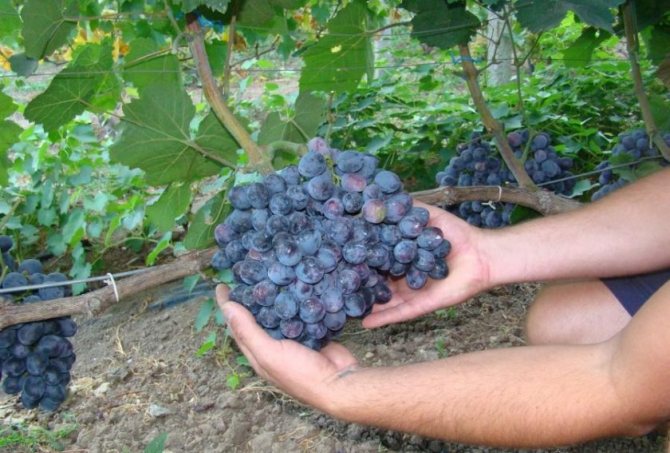

It is important to correctly carry out the basic plant care measures, which will allow you to get early and high-quality fruiting of the vine in your garden plot.
Watering and feeding
Experts recommend combining irrigation with fertilization. Thus, it is possible not only to save time, but also to achieve a better distribution of the applied fertilizers throughout the vineyard. The frequency of watering, as well as the amount of water used, should take into account the amount of natural precipitation, as well as indicators of soil moisture.
Particular importance is attached to watering during the flowering stage of the vineyard.When the berries ripen, on the contrary, one should not only reduce watering, but also stop applying nitrogen fertilizers, which will reduce the risk of berry cracking. In case of insufficient shoot growth, the fertilizer application rate should be increased or foliar dressing should be carried out. Humus or compost must be applied one year after planting, at the rate of 10 kg per square meter of vineyard.
Pruning is especially important for plants in the early years of development. It is at this stage that the yield indicators and the nature of the growth of the vine are laid. When pruning Gala hybrid grapes, it is recommended to leave 35 to 45 buds on each bush. Vines should be shortened by 6-8 eyes.
After reading the corresponding article on our website, you can learn about the technology of planting grapes by cuttings in spring and autumn.
Watering and fertilizing
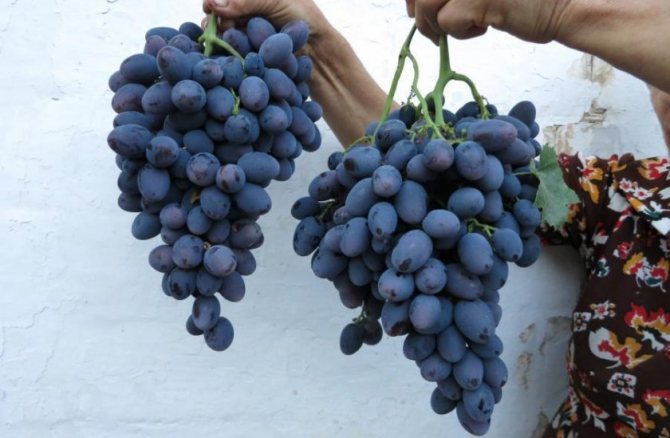

To make the harvest happy, you need to follow all agrotechnical instructions that have a positive effect on the plant. Activities carried out:
- mulching;
- watering;
- fertilizer;
- pruning;
- sheltering;
- treatment.
The added mulch controls the water balance in the soil, protects against low temperatures, and ensures the supply of oxygen and nutrients to the root system. The mulching procedure is carried out for the entire growing season: from planting to leaving for winter sleep.
Before the shelter, the plant is insulated: it is covered with peat, straw, humus. Organic mulch should take no more than 10 cm. Stagnant water also negatively affects the plant. The variety needs watering for the entire period of active growth, flowering and fruiting.
But this must be carefully monitored, taking into account the changeable weather, the peculiarities of the climatic zone, the qualitative composition of the earth. Active growth continues from April to October. Watering is strictly prohibited during the flowering period of the vine. Peduncles may crumble, and the fruits may not form.
Immediately, before accommodating the shoots for the winter, they need to be well moistened: water will come in handy for the whole winter. Pour under each bush: 70 l / 1 sq. M; during the growing season 50 l / 1 sq.m.
If you listen to the opinions of experienced gardeners, Gala constantly needs feeding. Only a young stalk does not require fertilization.
For teenage bushes, organic matter (compost, peat, humus) is suitable, which is applied: 10 kg / 1 m2 3 times. Minerals are brought in every year. In the spring, after the earth “moves away” from the snow and ice, ammonium nitrate or nitrogen is added to it.
Before the beginning of flowering and at the end of it, at the time of the formation of pea fruits on the bunches, you need to add potassium salts, superphosphate to the soil. This guarantees a good harvest.
Gala welcomes timely pruning. When the lianas are overloaded, the berries become smaller and lose their taste. There is not enough strength for the correct formation of the shoot, which affects the quality of the fruit.
In late autumn, before sheltering for the winter, it is better to shorten the vine, leaving at most 8 eyes. Kidneys - no more than 45 for the whole bush.
Protect the grapes from frost and winds by means of its shelter. The bushes are collected in a bunch, tied, laid on an insulating material (to protect against freezing), and fixed. Metal arcs are stuck into the ground, which are covered with a film.
On the sides, the "greenhouse" is sprinkled with soil to secure the structure and protect it from strong winds and heavy snowfall. From the sides, it remains possible to open the greenhouse during warming.
How to plant grapes
To achieve regular fruiting and high quality fruits, it is necessary to adhere to the basic rules when planting a plant.
Selection of seedlings
Further growth and development of grapes, first of all, will depend on the state of the planting material.Experts recommend purchasing seedlings in proven places, special nurseries or from familiar gardeners who are able to guarantee the quality of the material.
Before buying a seedling, it should be visually inspected for mechanical and biological damage, including symptoms of disease.


Signs of poor planting material are:
- The presence of dry, rotten, damaged root processes. A healthy root should have a milky white color on the cut that looks like a cut of a potato. A dark, dry cut point indicates tissue necrosis.
- Lack of vaccination site. The site of grafting should be clearly visualized on the stem of the seedling. If it is not there, then it is better to refuse to purchase this material.
- The presence of a large number of leaves and a stiff trunk. The foliage that remains on the trunk "steals" the plant's supply of moisture and nutrients, due to which it does not take root well and, as a result, does not bear fruit well.
- The presence of dry, black vines and bark. Experts recommend making small cuts on the vine: in a healthy plant, they are moist, have a fresh green color. Dull color and lack of juice indicate that the planting material is "dead". The same applies to the bark: the places where it is scraped should be green or gray.
Site preparation
It is recommended to plant seedlings in spring, when the risk of night return frosts is minimal. For Gala grapes, a well-lit area is perfect, where there are no cold winds and drafts. The variety prefers loose, soft soils with an average degree of salinity. Before carrying out planting activities, you need to loosen the soil well so that it is enriched with oxygen and nutrients.
Important! Since the variety belongs to plants with medium frost resistance, it is better to refuse to plant it in the fall.
Landing technology
Before immersing the seedlings in the soil, they should be thoroughly "revised": cut off dry, rotten and too long root shoots, and treat the cuts with chopped charcoal.
Further, it is recommended to plant a plant using the following technology:
- Dig a hole 80x80x80 cm in size.
- Lay a drainage layer at the bottom of the hole, and on top - a layer of fertile soil, about 30 cm high.
- Add 2-3 buckets of organic fertilizers and superphosphates to the hole.
- Lower a seedling into the hole under a slight slope, on which there are shoots with at least 2-3 buds.
- Dig the seedling about 10 cm with fed soil, cover it with ordinary soil on top. Do not tamp.
- In the hole, leave a distance at the top for watering the plant (about 5-10 cm).
- Around the hole, within a radius of 15 cm, make a groove, which is filled with mulch.


When planting several bushes, the distance between them should be at least 2.5 m.
Water abundantly after planting
Watering the grapes must be carried out using special holes. Before watering the plant, dig a hole about 40 centimeters in diameter around the root. Do not dig too close to the root as this may damage the system. Moreover, this method of irrigation helps to properly distribute the water and prevents it from stagnating.
- Watering immediately after the end of the planting procedure.
- Seven days after landing.
- When the seedlings reach thirty centimeters in height.
- Before the plant begins to bloom.
- The berries reach a diameter of half a centimeter.
- Before harvesting, in order to improve the quality of ripe berries.
- Last watering before covering the bush for the winter. In this case, the amount of water increases by half a bucket, it is also recommended to add Superphosphate to the water.
Watering
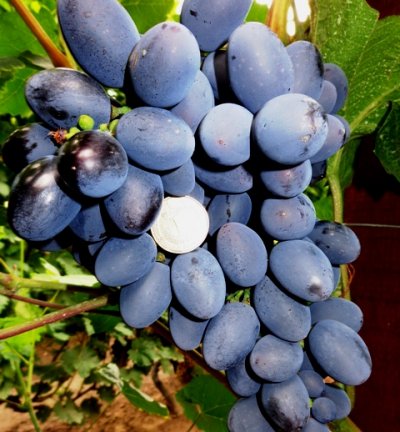

Correct watering is done exclusively through additional shallow holes with a diameter up to 40 cm - they are dug out at a short distance from the bush.
This method allows you to correctly control the water balance of the soil and not flood the bush.
Standard watering volume - 1-2 buckets.
The number of waterings is strictly defined.
The first watering is done after planting (or after tying).
The second watering - a little later, after pruning - no later than a week later.
The third watering is needed to stimulate growth when the shoots have grown up to 30 cm in height.
The fourth watering is carried out before the onset of the flowering period.
The next, fifth, watering - when the berries reach a size of about 0.5 cm in diameter.
The sixth watering is done to improve the quality of the crop, shortly before harvest.
The last watering is done before the shelter for the winter.



